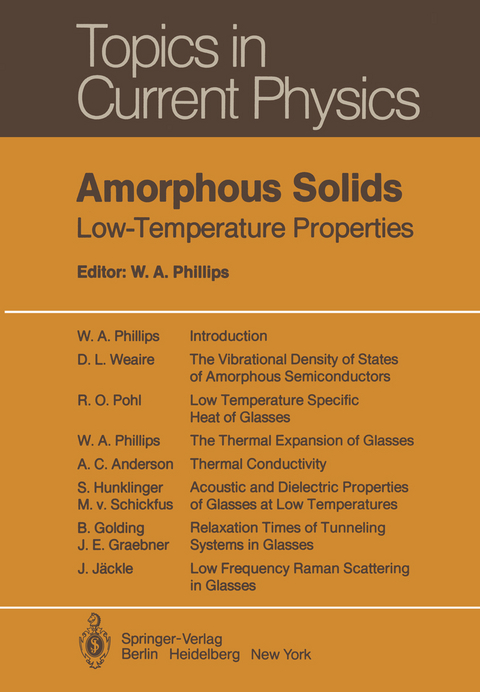
Amorphous Solids
Springer Berlin (Verlag)
978-3-642-81536-2 (ISBN)
1. Introduction.- 1.1 Historical Background.- 1.2 Tunneling States.- 1.3 Organization of the Book.- References.- 2. The Vibrational Density of States of Amorphous Semiconductors.- 2.1 The Vibrational Density of States.- 2.2 Experimental Techniques.- 2.3 The Theoretical Problem.- 2.4 Brute Force Theory.- 2.5 More Refined Approaches.- 2.6 The Incorporation of Matrix Elements.- 2.7 Can One Derive Structural Information from g(?)?.- 2.8 A Less Myopic View of the Field.- References.- 3. Low Temperature Specific Heat of Glasses.- 3.1 Review of the Experimental Situation.- 3.2 Comparison with Theoretical Models.- 3.3 Summary and Outlook.- References.- 4. The Thermal Expansion of Glasses.- 4.1 Theoretical Background.- 4.2 The High Temperature Expansion of Vitreous Silica.- 4.3 The Low Temperature Expansion of Glasses.- References.- 5. Thermal Conductivity.- 5.1 Thermal Transport in Crystalline Materials.- 5.2 Thermal Transport in Amorphous Materials.- 5.3 Probing the Localized Excitations.- 5.4 Synopsis.- References.- 6. Acoustic and Dielectric Properties of Glasses at Low Temperatures.- 6.1 General Comments.- 6.2 Acoustic and Dielectric Properties Above 10 K.- 6.3 Acoustic and Dielectric Properties Below 10 K.- 6.4 Theoretical Description of the Acoustic and Dielectric Properties by Two-Level Systems.- 6.5 Comparispn Between Theory and Experiment.- 6.6 Microscopic Description: Tunneling Model.- 6.7 Summary.- References.- 7. Relaxation Times of Tunneling Systems in Glasses.- 7.1 Background.- 7.2 Resonance Dynamics of Two-Level Systems.- 7.3 Experiments Measuring Relaxation Times.- 7.4 Critical Assessment of Data.- 7.5 Conclusions.- References.- 8. Low Frequency Raman Scattering in Glasses.- 8.1 Introductory Comments.- 8.2 Vibrational Raman Spectrum of First Order.- 8.3Quasielastic Spectrum.- 8.4 Conclusion.- References.- Additional References with Titles.- Subject and Material Index.
| Erscheint lt. Verlag | 21.12.2011 |
|---|---|
| Reihe/Serie | Topics in Current Physics |
| Co-Autor | A.C. Anderson, B. Golding, J.E. Graebner, S. Hunklinger, J. Jäckle, W.A. Phillips, R.O. Pohl, M.v. Schickfus, D.L. Weaire |
| Zusatzinfo | XII, 170 p. |
| Verlagsort | Berlin |
| Sprache | englisch |
| Maße | 170 x 244 mm |
| Gewicht | 328 g |
| Themenwelt | Naturwissenschaften ► Physik / Astronomie ► Atom- / Kern- / Molekularphysik |
| Naturwissenschaften ► Physik / Astronomie ► Festkörperphysik | |
| Technik ► Maschinenbau | |
| Schlagworte | Amorpher Halbleiter • Crystal • density • electron • Energy • experimental investigations • Glas • Heat • low temperature • Physics • scattering • semiconductor • solids • Temperature • Tieftemperatur |
| ISBN-10 | 3-642-81536-7 / 3642815367 |
| ISBN-13 | 978-3-642-81536-2 / 9783642815362 |
| Zustand | Neuware |
| Haben Sie eine Frage zum Produkt? |
aus dem Bereich


